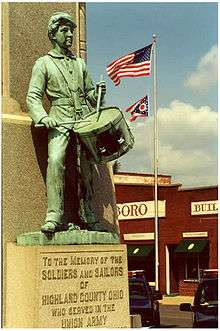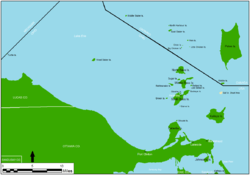Johnson's Island
|
Johnson Island Civil War Prison and Fort Site | |
|
The cemetery at Johnson's Island | |
  | |
| Location | Marblehead, Ohio |
|---|---|
| Coordinates | 41°29′47″N 82°43′55″W / 41.4964°N 82.7319°W |
| Built | 1862 |
| Architect | Hoffman,Col. William H.; Et al. |
| NRHP Reference # | 75001514[1] |
| Significant dates | |
| Added to NRHP | March 27, 1975 |
| Designated NHL | June 21, 1990[2] |
Johnson's Island is a 300-acre (120 ha) island in Sandusky Bay, located on the coast of Lake Erie, 3 miles (4.8 km) from the city of Sandusky, Ohio. It was the site of a prisoner-of-war camp for Confederate officers captured during the American Civil War. Johnson's Island was the only Union prison exclusively for Southern officers but, it also held regular soldiers . During its three years of operation, more than 15,000 men were incarcerated there.
The island was named after L. B. Johnson, an original owner of the island.[3]
Civil War years
In late 1861, Federal officials selected Johnson’s Island as the site for a prisoner of war camp to hold up to 2,500 captured Confederate officers. The island offered easy access by ship for supplies to construct and maintain a prison and its population. Sandusky Bay offered more protection from the elements than on other nearby islands, which were also closer to Canada in the event of a prison break. Woods of hickory and oak trees could provide lumber and fuel. The U.S. government leased half the island from private owner Leonard B. Johnson for $500 a year, and for the duration of the war carefully controlled access to the island.
The 16.5-acre (66,773.1 m2) prison opened in April 1862. A 15-foot-high (5 m) wooden stockade surrounded 12 two-story prisoner housing barracks, a hospital, latrines, sutler’s stand, three wells, a pest house, and two large mess halls (added in August 1864). More than 40 buildings stood outside the prison walls, including barns, stables, a limekiln, forts, barracks for officers, and a powder magazine. They were used by the 128th Ohio Volunteer Infantry, which guarded the prison.
Among the prominent Confederate generals imprisoned on Johnson's Island were Isaac R. Trimble and James J. Archer (both captured at the Battle of Gettysburg), William Beall, Thomas Benton Smith, Edward "Allegheny" Johnson and Missouri cavalryman M. Jeff Thompson. Lieutenant Christopher Columbus Nash, later the sheriff of Grant Parish, Louisiana, who directed the Colfax Riot in 1873, was also imprisoned at Johnson's Island.[4]
The prisoners had a lively community, with amateur theatrical performances, publishing, and crafts projects available.[5]
After the unraveling of a Confederate espionage ring which had been plotting the seizure of the Great Lakes warship USS Michigan and a mass breakout of prisoners, Forts Johnson and Hill were constructed over the winter of 1864–65. They were not operational until March 1865, in the war's final months, when the prisoner population peaked at 3,200. More than 15,000 men passed through Johnson’s Island until it was closed in September 1865. Wardens lost only about 200 prisoners as a result of the harsh Ohio winters, food and fuel shortages, and disease. Johnson's Island had one of the lowest mortality rates of any Civil War prison. Confederates made many escape attempts, including efforts by some to walk across the frozen Lake Erie to freedom in Canada. A handful of escapes were successful.
Postbellum

After the war, the prison camp was abandoned and control reverted to the owner. Most of the buildings were auctioned off by the Army, and some were razed after falling into disrepair. Efforts in 1897 to turn the island into a resort (as with nearby Cedar Point) failed, and the land was used for farming and rock quarrying. Many lakeside homes have since been built, and the island is now quite developed with two subdivisions. Most of the Civil War-related sites, excepting the cemetery, have since been destroyed and built over.
In 1990 Johnson’s Island was designated a National Historic Landmark. A causeway was built to connect it with the mainland. The Confederate cemetery, as well as Fort Hill in the interior of the island, are accessible to the public. Ground-penetrating radar studies have proved that several graves lie outside its fence. Heidelberg University conducts yearly archeology digs at the prison site.[6]
The Friends and Descendants of Johnson's Island Civil War Prison was formed in 2001 to help in the preservation, interpretation, and education of the Johnson's Island Prison site. In conjunction with Heidelberg University, the Friends have sponsored educational and research programming at this National Historic Landmark. To search for ancestors that may have been incarcerated at Johnson's Island, one may contact the Friends internet site.
See also
- List of Civil War POW Prisons and Camps
- Prisoner of war mail
- Davids' Island
References
- ↑ National Park Service (2007-01-23). "National Register Information System". National Register of Historic Places. National Park Service.
- ↑ Johnson's Island Civil War Prison
- ↑ Overman, William Daniel (1958). Ohio Town Names. Akron, OH: Atlantic Press. p. 66.
- ↑ "Nash, Christopher Columbus". A Dictionary of Louisiana Biography (lahistory.org). Retrieved December 16, 2010.
- ↑ Britten, Christopher (Spring 2010). "Cooped Up and Powerless When My Home Is Invaded: Southern Prisoners at Johnson's Island in Their Own Words". Ohio Valley History. 10 (1): 53–72.
- ↑ "Field School". Heidelberg University (heidelberg.edu). Retrieved May 15, 2014.
External links
| Wikimedia Commons has media related to Johnson's Island. |
- Friends and Descendants of Johnson's Island
- Johnson's Island Memorial Project Broken Link.
- Johnson's Island Preservation Society - includes Johnson's Island Museum
- Roy Swartz's Johnson's Island Page
- Historic American Landscapes Survey (HALS) No. OH-1, "Confederate Stockade Cemetery, Johnson's Island, Sandusky, Erie County, OH"
- Johnson's Island Prison Collector Community
Coordinates: 41°29′47″N 82°44′05″W / 41.4963°N 82.7346°W

